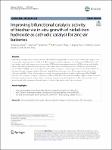Item Infomation
Full metadata record
| DC Field | Value | Language |
|---|---|---|
| dc.contributor.author | Zhang, Pengxiang | - |
| dc.contributor.author | Sun, Kang | - |
| dc.contributor.author | Liu, Yanyan | - |
| dc.date.accessioned | 2023-10-03T07:29:39Z | - |
| dc.date.available | 2023-10-03T07:29:39Z | - |
| dc.date.issued | 2023 | - |
| dc.identifier.uri | https://link.springer.com/article/10.1007/s42773-023-00259-1 | - |
| dc.identifier.uri | https://dlib.phenikaa-uni.edu.vn/handle/PNK/9428 | - |
| dc.description | CC-BY | vi |
| dc.description.abstract | Expanding the application scenarios of wood-derived biochar guided by the conversion of traditional energy to new energy shows great promise as a field. As thrilling energy conversion apparatus, zinc-air batteries (ZABs) require cathode catalysts with high oxygen reduction reaction (ORR) and oxygen evolution reaction (OER) activities and stability. Herein, two-dimensional nickel-iron hydroxide nanosheets were creatively assembled in N-doped wood-derived biochar (NiFe-LDH@NC) by an in-situ growth method. The categorized porous organization in wood-derived biochar facilitates the rapid seepage of electrolytes and rapid diffusion of reaction gases. The unique interfacial structure of biochar and NiFe-LDH accelerates electron transfer during oxygen electrocatalysis, and endows NiFe-LDH@NC with first-class catalytic activity and durability for ORR and OER. The ZAB derived from NiFe-LDH@NC showed elevated discharge productivity and cycle endurance, making it promising for viable applications. | vi |
| dc.language.iso | en | vi |
| dc.publisher | Springer | vi |
| dc.subject | NiFe-LDH@NC | vi |
| dc.subject | NiFe-LDH | vi |
| dc.title | Improving bifunctional catalytic activity of biochar via in-situ growth of nickel-iron hydroxide as cathodic catalyst for zinc-air batteries | vi |
| dc.type | Book | vi |
| Appears in Collections | ||
| OER - Khoa học môi trường | ||
Files in This Item:

